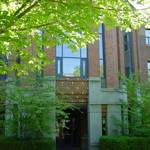UO Computer Science Department Turns 30

April 12, 2000
Contact: Ross West (541) 346-2060
EUGENE–Pulitzer Prize-winning author Douglas Hofstadter will deliver a keynote address on Saturday, April 15, in celebration of the 30th anniversary of the University of Oregon Department of Computer and Information Science (CIS), one of the oldest computer science departments in the country.
Hofstadter’s lecture, free and open to the public, will take place at 7:30 p.m. in Room 100 in Willamette Hall, 1371 E. 13th Ave., on the UO campus. It will cap a full day of festivities planned to celebrate the department’s three decades of existence.
An open house from 1—5 p.m. will offer informal discussions with researchers and tours of selected laboratories in the CIS building, Deschutes Hall, 1477 E. 13th Ave.
Hofstadter, one of the department’s most famous graduates, won the Pulitzer Prize for his 1979 book "Goedel, Escher, Bach: An Eternal Golden Braid." In his lecture, "Will Spiritual Robots Replace Humanity by 2100?", he will address the future relationship between computers and humans.
From clunky main frame computers to the widespread proliferation of the personal computer and now to the vast possibilities offered by the Internet, the past 30 years may someday be looked back upon as the golden age of computer science, says department head Sarah Douglas.
The University of Oregon was among the forward-looking universities to first recognize the importance of computer science with the creation in the fall of 1969 of a department dedicated to the field.
"Like most of the early computer science departments, we have our roots in the mathematics department where the computational value of computers was clear early on," says Douglas.
In the early days, the department’s three founding faculty members–David Moursund, George Struble and Fred Andrews–relied on the "big iron" of the university’s IBM 360 mainframe computer. This single vintage 1966 machine carried the load for the university’s administrative, instructional and research needs. This dinosaur, like its biological counterpart, was huge and had a small brain. The hulking box ran on a mere 256 kilobytes of memory and operated using punch cards. According to Moursund, the IBM 360 was much less powerful than a typical desktop PC today.
CIS initially offered bachelor of science and master of science degrees in computer science, but added the Ph.D. in 1982.
"Before we began offering the Ph.D., the department was more focused on teaching. After that, we shifted toward a much greater emphasis on research," Douglas says.
Today, CIS is one of the larger departments on campus with 546 students enrolled at all levels in the fall of 1999. Over the course of three decades, CIS has awarded more than 1,800 degrees.
The far-ranging research interests of the 18 faculty members currently in the department include programming languages, parallel processing and programming environments, human-computer interaction, computational theory, software engineering, graphics, computational biomechanics and, of course, networking and the Internet.
As research interests have broadened, so has the department’s degree offerings. In addition to bachelor’s, master’s and doctoral degrees in computer science, students also can now work toward B.S. and M.S. degrees in "math-computer science," offered jointly with the Department of Mathematics; a master of software engineering offered in collaboration with Portland State University, the Oregon Graduate Institute and Oregon State University at the UO Downtown Center in Portland; and two minors, in computer science and computer information technology.
The burgeoning department got a substantial upgrade with the completion of Deschutes Hall a little more than a decade ago. The three-story, 30,000-square-foot structure is a vast improvement over the department’s previous campus quarters in the cramped basement of Prince Lucien Campbell Hall. Adorning the exterior of Deschutes Hall are castings of two computer science pioneers, Alan Turing and John von Neumann.
Nestled inside Deschutes Hall is the Computational Science Institute. Established in September 1995, the institute is an association of researchers from nine different UO departments collaborating to apply the computational muscle of parallel computing to a wide array of research pursuits. The institute supports this work with the UO’s parallel supercomputers that are networked to researchers around the state and to national supercomputing centers.
For more information about the 30th anniversary events, call (541) 346-4408 or visit the CIS website at http://www.cs.uoregon.edu/info/anniversary.html.